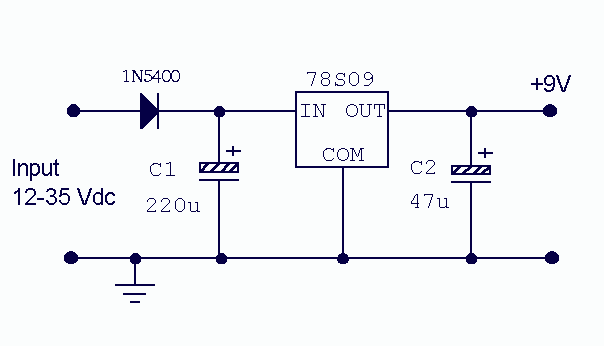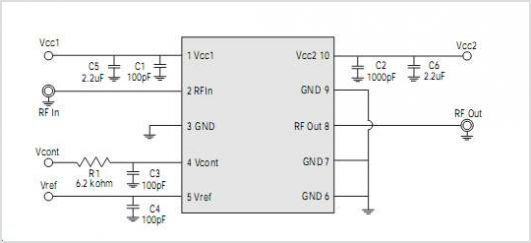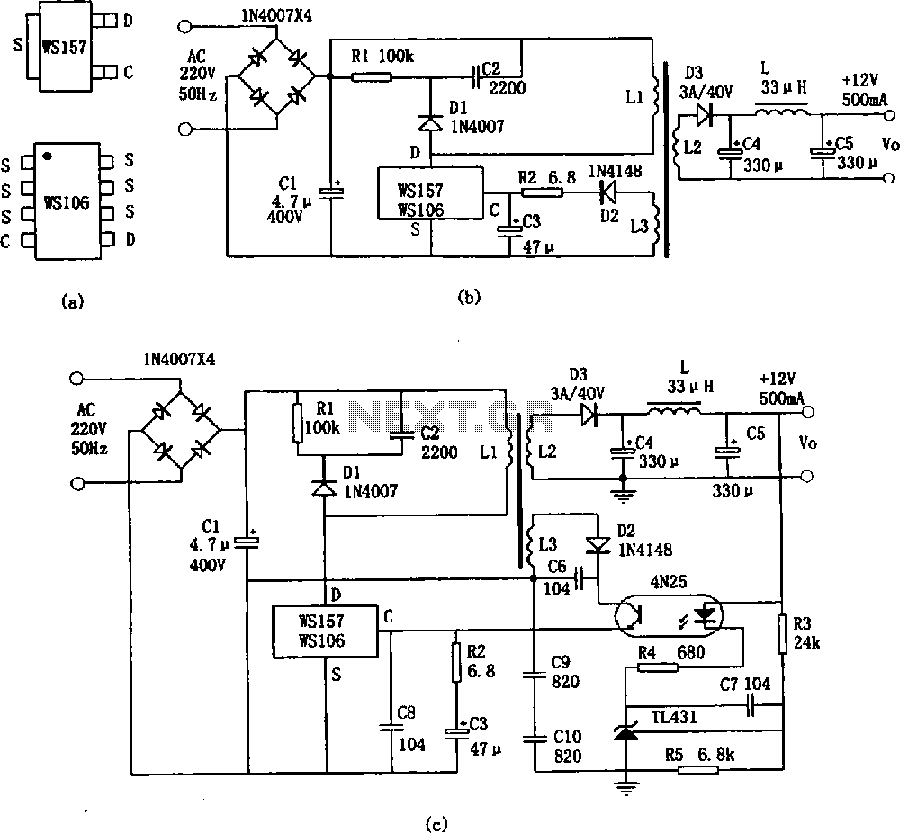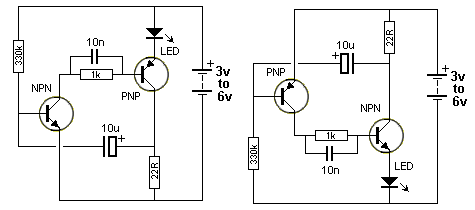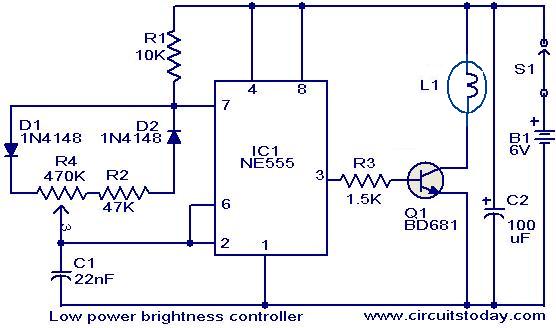
switching power supply 2
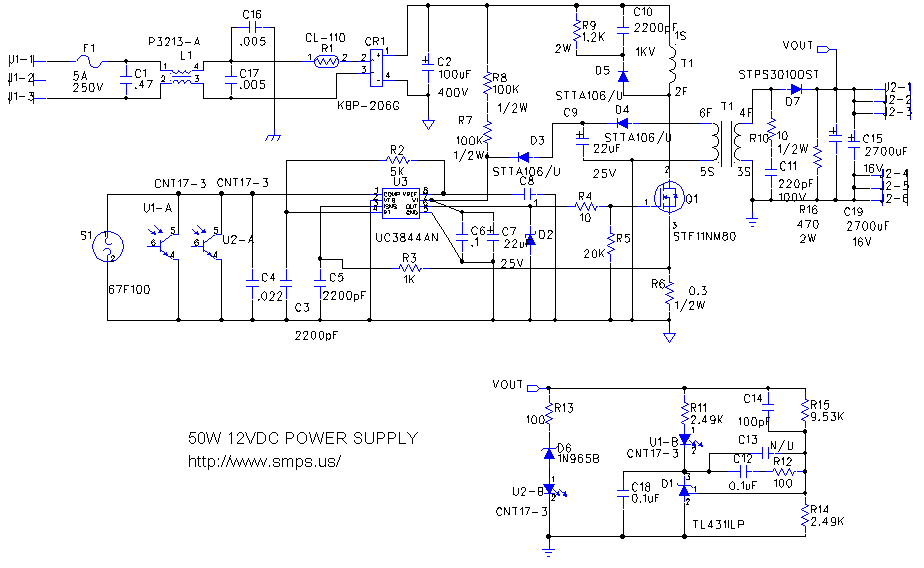
This circuit is designed to double nearly any DC input voltage while handling a substantial amount of current. For instance, it can work with input voltages ranging from 12 to 24V. With minor modifications, it can also provide any desired output voltage. The circuit has numerous potential applications, such as generating the 28V required for the ADC connector on Gigabit Ethernet and Power Macintosh G4 systems from a standard +12V output of a PC ATX power supply. It is useful in scenarios where a higher voltage is needed than what is currently available, such as during camping trips where 12-14V is required but only 6V cells are available. Additionally, it can enhance the cooling performance of computer fans, provided they can tolerate the increased voltage. The circuit can be employed to boost the speed and airflow of standard 80mm DC brushless fans. White LED backlights are becoming more popular due to their higher reliability and simpler drive circuitry compared to CCFL and EL technologies. Consequently, white LED backlighting is increasingly used in PDAs, cell phones, digital cameras, and other portable devices. A design that requires prolonged backlighting necessitates an efficient circuit to drive the LEDs with a regulated current, eliminating the power waste associated with current-limiting resistors. A flyback converter can serve as a current-limited power supply for charging lead-acid batteries. The MAX773 current-mode controller restricts the output current, while the flyback transformer provides both isolation and flexibility for input voltages above or below the battery voltage. The MAX471 current-sense amplifier monitors the charging current and provides feedback to a threshold detector, allowing the flyback converter to switch to a lower charging voltage for trickle-charge mode when the current drops below a specified threshold. The circuit shown charges lead-acid batteries conventionally by maintaining a constant voltage across the battery (approximately 2.4V per cell, as indicated by the manufacturer) until the charging current falls below a threshold defined by the battery's capacity. At this point, the charger enters trickle-charge mode. The current threshold is typically set at 0.01C, where C represents the battery capacity in ampere-hours. When charging, the term "C rate" refers to the current theoretically required to charge a battery to its full capacity in one hour. In reality, energy losses during the charging process result in longer charging times. Ideally, a 5A-hr battery could be charged in one hour with a 5A current. Similarly, a C/10 charge rate (500mA) would charge the same battery in 10 hours, though power losses extend these times. In conventional applications, switching-regulator ICs maintain VOUT by controlling the current through an external inductor. However, in this circuit, a diode-capacitor network replaces the inductor, offering comparable performance for small loads using readily available components. This network can double, triple, or quadruple the input voltage. Although it is somewhat less efficient than inductor-based regulators, the circuit provides equivalent line and load regulation. The supply operates by shorting the inductor across the 12 volts through the regulator, storing energy in the inductor. When the internal switch in the LT1170 turns off, the inductor is placed in series with the 12 volts, adding to the voltage. This pulse is then stored in the output capacitor, which smooths the output. A diode prevents the output capacitor from discharging during switching. The circuit includes a 100 kHz current-based oscillator, with its output controlled by feedback from resistors R1 and R2, which form a voltage divider to achieve the desired output voltage.
This circuit description outlines a versatile DC-DC converter that can be tailored to various voltage requirements and applications. It employs a flyback converter topology, which is particularly advantageous for battery charging and LED drive applications due to its efficiency and flexibility in handling different input voltage ranges. The use of a current-mode controller ensures that the output current remains within safe limits, protecting both the circuit and the load. The integration of feedback mechanisms allows for precise voltage regulation, making this circuit suitable for sensitive electronic applications where stability is crucial. The combination of a diode-capacitor network in place of traditional inductive components further enhances the design's adaptability, enabling it to meet the demands of diverse electronic systems while maintaining efficiency and performance standards. Overall, this circuit serves as a reliable solution for applications requiring increased voltage from lower DC sources, making it an invaluable tool in the field of electronics.This circuit will double almost any DC input voltage as well as handling plenty of current. 12 to 24V is just an example. With a few changes, it can also supply any desired output voltage. There are many possible applications. One I can think of would be to get the 28V for the ADC connector on Gigabit Ethernet and later Power Macintosh G4s from th e +12V on a standard PC ATX power supply. Basically any time you need more voltage than what you`ve got. Possibly on camping trips when you need 12-14 volts but only have 6V cells. Also you can use it to boost the cooling power of the fans in your computer if they can handle the extra voltage. Some can`t. Keep reading for more on this. What I use it for is to increase the speed and thus the airflow of a standard 80mm DC brushless fan. White-LED backlights are gaining acceptance because they offer higher reliability and simpler drive circuitry than those based on CCFL and EL technology.
As a result, the white-LED backlight is increasingly common in PDAs, cell-phones, digital cameras, and other portable devices. A design in which the display is backlit (or frontlit) for extended periods needs an efficient circuit that drives the LEDs with a controlled current, and eliminates the wasted power associated with current-limiting resistors.
A flyback converter implements a current-limited power supply to charge lead-acid batteries. The MAX773 current-mode controller limits the output current and the flyback transformer provides isolation and flexibility for input voltages both above and below the battery voltage. The MAX471 current-sense amplifier monitors the charging current and feeds back to a threshold detector so that below a designed threshold the flyback converter can switch to a lower charging voltage for trickle-charge mode.
The circuit shown in Figure 1 charges lead-acid batteries in the conventional way: A current-limited power supply maintains a constant voltage across the battery (2. 4V/cell or so, as specified by the battery manufacturer) until the charging current decreases below a current threshold defined by the capacity of the battery.
At this point, the charger is placed in a trickle-charge mode. The current threshold is typically 0. 01C, where C refers to the battery capacity, which is specified in ampere-hours. When charging a battery, the term C rate refers to the current required, in theory, to charge a battery to its full battery capacity C in one hour. In actuality, power lost during the charge cycle ensures that all batteries charged at their C rate take more than an hour to reach full charge.
Ideally, you could charge a 5A-hr battery in one hour if the charge current is 5A. Also, ideally, a C/10 charge rate (500mA) charges the same battery in 10 hours. However, the power loss mentioned previously increases these charge times beyond the two time spans stated above. In conventional applications, switching-regulator ICs regulate VOUT by controlling the current through an external inductor.
The IC in Figure 1, however, driving a diode-capacitor network in place of the inductor, offers comparable performance for small loads. Made of readily available components, the network can double, tripple or quadruple the input voltage.
Though somewhat less efficient than inductor-type regulators, the Figure 1 circuit offers equivalent line and load regulation. The supply works by shorting the inductor across the 12 volts through the regulator. This stores energy in the inductor. When the internal switch in the LT1170 goes off, the inductor is placed in series with the 12 volts, adding to it.
This voltage pulse is stored in the output capacitor and smooths the output. The diode is used to keep the output capacitor from discharging during switching. It contains a 100 khz current based oscilator whose output is controled by feedback provided by R1 and R2. These make a voltage divider such that at the wanted output volta 🔗 External reference
This circuit description outlines a versatile DC-DC converter that can be tailored to various voltage requirements and applications. It employs a flyback converter topology, which is particularly advantageous for battery charging and LED drive applications due to its efficiency and flexibility in handling different input voltage ranges. The use of a current-mode controller ensures that the output current remains within safe limits, protecting both the circuit and the load. The integration of feedback mechanisms allows for precise voltage regulation, making this circuit suitable for sensitive electronic applications where stability is crucial. The combination of a diode-capacitor network in place of traditional inductive components further enhances the design's adaptability, enabling it to meet the demands of diverse electronic systems while maintaining efficiency and performance standards. Overall, this circuit serves as a reliable solution for applications requiring increased voltage from lower DC sources, making it an invaluable tool in the field of electronics.This circuit will double almost any DC input voltage as well as handling plenty of current. 12 to 24V is just an example. With a few changes, it can also supply any desired output voltage. There are many possible applications. One I can think of would be to get the 28V for the ADC connector on Gigabit Ethernet and later Power Macintosh G4s from th e +12V on a standard PC ATX power supply. Basically any time you need more voltage than what you`ve got. Possibly on camping trips when you need 12-14 volts but only have 6V cells. Also you can use it to boost the cooling power of the fans in your computer if they can handle the extra voltage. Some can`t. Keep reading for more on this. What I use it for is to increase the speed and thus the airflow of a standard 80mm DC brushless fan. White-LED backlights are gaining acceptance because they offer higher reliability and simpler drive circuitry than those based on CCFL and EL technology.
As a result, the white-LED backlight is increasingly common in PDAs, cell-phones, digital cameras, and other portable devices. A design in which the display is backlit (or frontlit) for extended periods needs an efficient circuit that drives the LEDs with a controlled current, and eliminates the wasted power associated with current-limiting resistors.
A flyback converter implements a current-limited power supply to charge lead-acid batteries. The MAX773 current-mode controller limits the output current and the flyback transformer provides isolation and flexibility for input voltages both above and below the battery voltage. The MAX471 current-sense amplifier monitors the charging current and feeds back to a threshold detector so that below a designed threshold the flyback converter can switch to a lower charging voltage for trickle-charge mode.
The circuit shown in Figure 1 charges lead-acid batteries in the conventional way: A current-limited power supply maintains a constant voltage across the battery (2. 4V/cell or so, as specified by the battery manufacturer) until the charging current decreases below a current threshold defined by the capacity of the battery.
At this point, the charger is placed in a trickle-charge mode. The current threshold is typically 0. 01C, where C refers to the battery capacity, which is specified in ampere-hours. When charging a battery, the term C rate refers to the current required, in theory, to charge a battery to its full battery capacity C in one hour. In actuality, power lost during the charge cycle ensures that all batteries charged at their C rate take more than an hour to reach full charge.
Ideally, you could charge a 5A-hr battery in one hour if the charge current is 5A. Also, ideally, a C/10 charge rate (500mA) charges the same battery in 10 hours. However, the power loss mentioned previously increases these charge times beyond the two time spans stated above. In conventional applications, switching-regulator ICs regulate VOUT by controlling the current through an external inductor.
The IC in Figure 1, however, driving a diode-capacitor network in place of the inductor, offers comparable performance for small loads. Made of readily available components, the network can double, tripple or quadruple the input voltage.
Though somewhat less efficient than inductor-type regulators, the Figure 1 circuit offers equivalent line and load regulation. The supply works by shorting the inductor across the 12 volts through the regulator. This stores energy in the inductor. When the internal switch in the LT1170 goes off, the inductor is placed in series with the 12 volts, adding to it.
This voltage pulse is stored in the output capacitor and smooths the output. The diode is used to keep the output capacitor from discharging during switching. It contains a 100 khz current based oscilator whose output is controled by feedback provided by R1 and R2. These make a voltage divider such that at the wanted output volta 🔗 External reference
Warning: include(partials/cookie-banner.php): Failed to open stream: Permission denied in /var/www/html/nextgr/view-circuit.php on line 713
Warning: include(): Failed opening 'partials/cookie-banner.php' for inclusion (include_path='.:/usr/share/php') in /var/www/html/nextgr/view-circuit.php on line 713
